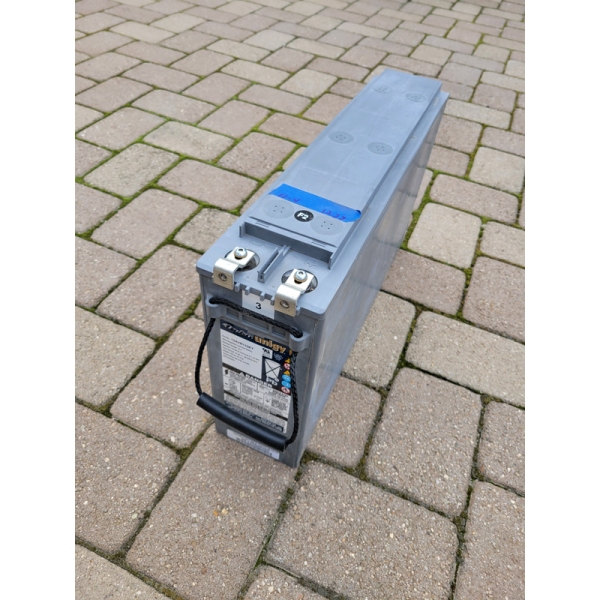- Product Details
Deka Unigy I 12AVR170ET Valve Regulated Lead Acid Battery 12V LOT
12AVR170ET
The Deka Unigy I battery features top terminal design available in a range of 27 – 130 AH capacities, and front access terminal design available in a range of 100 – 200 AH capacities.
FEATURES
- 12-volt monobloc battery available in both top and front access designs
- Wide range of capacities with ratings from 27-200 AH @ 8 hours to 1.75 v.p.c.
- Exclusive IPF® Technology optimizes power capacity, cell consistency, and long-term reliability
- Advanced AGM technology eliminates periodic watering, corrosive acid fumes, and spills
- Epoxy-sealed posts eliminate leaks
- Flame arresting, low pressure, self-sealing valves are all 100% factory tested
Exclusive IPF® technology optimizes power capacity, cell consistency, and long-term reliability
Advanced AGM technology for superior power
Puncture resistant micro-porous glass mat separators extend life
Front access design for easy installation and maintenance
Reinforced case resists bulging and meets safety requirements (UL 94 V-0)
Case & cover heat sealed and 100% tested to prevent leaks
Epoxy sealed posts eliminate leaks
Flame arresting, low-pressure, self-sealing valves are 100% factory tested
Computer-aided design and manufacturing control processes and standards to ensure quality products
All batteries meet or exceed IEEE recommended practices
Battery design and construction meet UL recognition requirements
Plate thickness optimized for long life
Guaranteed 100% initial string capacity when tested in accordance with IEEE 1188
Designed to meet GR4228 specifications
48 volt system fits in 23" relay rack tray
SPECIFICATIONS
Nominal Voltage: 12-Volts
Rating: 170 Ampere-Hours @ 8 hr. rate to 1.75 V.P.C.
Positive Plate: >98% Pure lead with tin-calcium alloy
Negative Plate: Pure lead, calcium alloy
Post Seal: Epoxy-sealed
Terminal: Front access, 1/4" – 20 threaded insert
Case/Cover: Flame-retardant, polypropylene – UL 94 V-0/>28% L.O.I.
Safety Vent: Low positive pressure, self-sealing w/ flame arrestor
Float Voltage: 2.25 V.P.C. ± 0.01 V.P.C. @ 77°F (25°C)
Design life: 10 years in float applications @ 77°F (25°C)
Dimensions: Length - 22.17" (563.2 mm) Width - 4.97" (126.3 mm) Height - 12.60" (320.0 mm)
Weight: 119 Ibs. (54 kg)
DISCHARGE RATINGS IN AMPS @ 77°F (25°C)†
Volts per Cell (V.P.C.)
1 HR. 2 HR. 3 HR. 4 HR. 5 HR. 8 HR. 12 HR. 20 HR. 24 HR.
1.75 108 63.5 46.1 36.7 30.8 21.2 14.8 9.4 8.0
1.80 103 62.1 45.3 36.1 30.3 20.9 14.6 9.2 7.8
1.85 94.4 58.9 43.4 34.7 29.2 20.2 14.1 8.9 7.6
1.88 88.0 55.8 41.3 33.1 27.9 19.4 13.5 8.6 7.3
1.90 83.1 53.0 39.5 31.8 26.8 18.6 13.0 8.2 7.0
DOCUMENTS
- Telecom Solutions Flyer (1614)
- Telco Rack Systems Flyer (1360)
- 12AVR145ET Flyer (1398)
- 12AVR130 Flyer (0982)
- 12AVR100ET Flyer (0949)
- 12AVR75 Flyer (2382)
- 12AVR90 Flyer (0384)
- 12AVR100 Flyer (0955)
- 12AVR40 Flyer (2383)
- 12AVR200ET Flyer (2006)
- 12AVR170ET Flyer (1283)
- 12AVR150ET Flyer (0969)
- Unigy I I&O Manual (0902) INSTALLATION AND OPERATING INSTRUCTIONS
ADVANTAGES OF DEKA AGM BATTERIES
Deka is a leading provider of high-end AGM batteries for marine, RV, and other power sports applications. The Deka family of batteries is known for both their reliability and versatility.
The Deka brand was created to power a wide range of outdoor equipment on water and on land. Deka AGM batteries are leak-proof and cold-resistant to handle the extreme conditions of power sports.
SOLAR + BATTERY STORAGE FAQs
Watt vs kWh?
Watts (W)
A watt (W) is a unit of measurement of power. Watts therefore refer to the power of your device.
eg:
- An incandescent lamp has a power of 60 W
The watt, as its many variations – kilowatt, megawatt, etc. – measures the electrical power of a device, whether it is a motor, a machine or the heating capacity of a boiler or wood stove. Today, this information appears on the technical descriptions for all electrical appliances. The more powerful a device is, the higher the number of watts.
Kilowatt hours (kWh)
A kilowatt hour (kWh) is a unit of measurement of energy. A kilowatt hour therefore refers to the consumption of your device.
1 kilowatt hour (kWh) is the energy consumed by a 1,000-watt or 1-kilowatt electrical appliance operating for 1 hour.
eg:
- a 60 W lamp that burns for one hour will have consumed 60 Wh or 0.06 kWh
1 kilowatt hour (kWh) = 1,000 watt hours (Wh)
1 megawatt hour (MWh) = 1,000 kilowatt hours (kWh)
1 gigawatt hour (GWh) = 1,000 megawatt hours (MWh)
To calculate the consumption of an electrical appliance in kWh:
- the power of your electrical appliance, in watts.
- the number of hours that the appliance is in use in one day.
- the number of days per year when the appliance is in use.
The calculation of Energy Consumption of an electrical appliance:
[number of hours’ use] x [number of days’ use] x ([capacity of appliance expressed in watt] / 1,000) = number of kWh
Convert Amp Hours To Watt Hours
Calculate both watt hours and amp hours to determine battery’s energy capacity, what voltage needed and the thickness of your wires needed. Although amp hours and watt hours are distinct units of measurement, it’s important to know that they are related and that one can be used to determine the other.
- Watt Hours = Power Over Time
- Amp Hours = Current Over Time
“Voltage” times “Amp Hours" equals “Watt Hours”
- Watt Hours = Amp Hours x Volts
- Amp Hours = Watt Hours / Volts
For a 12V battery and that battery is rated for 170 Ah. You can multiply the 170 Ah times the 12V, which gives you 2040 Wh. To further demonstrate how amp hours differ from watt hours, you would also be able to achieve the same 2040 Wh with a 24V (higher voltage), 85 Ah (lower Ah) battery.
12V x 170 Ah = 2040 Wh
24V x 85 Ah = 2040 Wh
48V x 42.5 Ah = 2040 Wh
HOW BIG A LEAD ACID BATTERY ARRAY NEEDED TO POWER A HOME?
Sizing solar batteries is one of the first steps in designing your off-grid system. If you don’t have enough battery capacity, you run out of power and you'll need to add battery backup and fire up the backup generator. If you buy too many batteries, you add unnecessary expense to your system, with extra components, complexity and maintenance. The amount of battery storage you need is based on your energy usage. Energy usage is measured in kilowatt hours over a period of time.
eg:
~ 1,000 watts x 10 hours per day = 10 kWh per day
~ 1463 watts x 8 hours per day = 11.7 kWh per day
~ 1458 watts x 12 hours per day = 17.5 kWh per day
~ 1456 watts x 16 hours per day = 23.3 kWh per day
~ 1083 watts x 24 hours per day = 26 kWh per day
~ 1375 watts x 24 hours per day = 33 kWh per day [average household daily energy consumption of about 26 to 33 kWh]
~ 1458 watts x 24 hours per day = 35 kWh per day
Sizing Battery Bank
The exact math for sizing your battery system is based on your daily power usage and the battery type. Based on usage of 10kWh per day, eg.
Lead Acid Battery Sizing
10 kWh x 2 (for 50% depth of discharge) x 1.2 (inefficiency factor) = 24 kWh
11.7 kWh x 2 (for 50% depth of discharge) x 1.2 (inefficiency factor) = 28.08 kWh
17.5 kWh x 2 (for 50% depth of discharge) x 1.2 (inefficiency factor) = 42 kWh
23.3 kWh x 2 (for 50% depth of discharge) x 1.2 (inefficiency factor) = 55.92 kWh
26 kWh x 2 (for 50% depth of discharge) x 1.2 (inefficiency factor) = 62.4 kWh
33 kWh x 2 (for 50% depth of discharge) x 1.2 (inefficiency factor) = 79.2 kWh
35.0 kWh x 2 (for 50% depth of discharge) x 1.2 (inefficiency factor) = 84 kWh
Battery capacity is specified either in Kilowatt Hours, or Amp Hours.
eg.,
24 kWh = 2000 amp hours X 12 volts = 24 kWh
24 kWh = 1000 amp hours X 24 volts = 24 kWh
24 kWh = 500 amp hours X 48 volts = 24 kWh
28.08 kWh = 585 amp hours X 48 volts = 28.08 kWh
42 kWh = 875 amp hours X 48 volts = 42 kWh
55.92 kWh = 1165 amp hours X 48 volts = 55.92 kWh
62.4 kWh = 1300 amp hours X 48 volts = 62.4 kWh [daily energy consumption of about 26 kWh]
79.2 kWh = 1650 amp hours X 48 volts = 79.2 kWh [daily energy consumption of about 33 kWh]
84 kWh = 1750 amp hours X 48 volts = 84 kWh
Round up to help cover inverter inefficiencies, voltage drop and other losses. Consider this as the minimum battery bank size based on the typical usage. Round up to 600-800 amp hours as the capacity, based on this example, depending on your budget and other factors.
Battery banks are typically wired for either 12 volts, 24 volts or 48 volts depending on the size of the system.
Factors to consider for battery sizing:
- Seasonal Factors - People use more power at different times of the year. The sun produces more power in the summer than in the winter.
- Budget - Battery bank size is often a compromise between what you want to spend on batteries and how often you'll need to run your backup generator.
- Daily Energy Usage - You'll want to look to your electric bill for this information. It will usually be printed as your monthly kilowatt-hour output. To calculate your daily kilowatt-hour output, you will need to divide that number by 30, then multiply by 1000 to convert the number into watt-hours. Which translates to one watt of power sustained for one hour. This is the first step in determining your solar battery bank size.
- How many Sunny Days - Estimate How Many Days Your Solar System Will Be Without Sun. If you don't know this information off-hand, you can look up the annual average of cloudy days for your area online. This step is crucial in ensuring you'll have access to your solar energy year-round. A large solar battery bank size will be best utilized in areas with more cloudy days, while a smaller solar battery bank should be sufficient in areas with a lot of sunlight. However, it's always recommended to size up rather than down.
- Ambient Temperature - Heat or cold has a big impact on battery performance and capacity. Estimate the Lowest Temperature Your Battery Bank Will Experience. You can search the average low temperature for your area online. This step will help accurately predict the adequate capacity of your battery bank.
Average Electrical Energy Consumption Comparison in USA
CALIFORNIA
Average Monthly Consumption (kWh) 542 kWh
Average Price (cents/kWh) 24 cents/kWh [2023]
Solar Price (cents/kWh) 18 cents/kWh [2023 25 years lease]
NEW YORK
Average Monthly Consumption (kWh) 599 kWh
Average Price (cents/kWh) 19 cents/kWh
Solar Price (cents/kWh)
TEXAS
Average Monthly Consumption (kWh) 1094 kWh
Average Price (cents/kWh) 12 cents/kWh
Solar Price (cents/kWh)
On average, an USA household consumes around 800 to 1,000 kWh of electricity per month, totaling approximately 9,600 to 12,000 kWh annually. When divided by the number of days in a year, this translates to an average daily energy consumption of about 26 to 33 kWh, equivalent to 26,000 to 33,000 watt-hours per day. The monthly consumption is about 26 kWh x 30 days = 780 kWh to 33 kWh x 30 days=990 kWh.
BATTERY SIZE NEEDED ESTIMATE
For daily energy consumption of about 18 kWh BATTERY SIZE NEED IS 43.4 kWh
For daily energy consumption of about 26 kWh BATTERY SIZE NEED IS 62.4 kWh
For daily energy consumption of about 33 kWh BATTERY SIZE NEEDED IS 79.2 kWh
For monthly energy consumption of about 542 kWh BATTERY SIZE NEED IS 43.4 kWh
For monthly energy consumption of about 780 kWh BATTERY SIZE NEED IS 62.4 kWh
For monthly energy consumption of about 990 kWh BATTERY SIZE NEEDED IS 79.2 kWh
HOW MANY LEAD ACID BATTERIES PER BATTERY BANK (STRING) ?
eg.
12V System - 1 x 12V Battery Per Bank
24V System - 2 x 12V Batteries in Series Per Bank
48V System - 4 x 12V Batteries in Series Per Bank
Selecting the right voltage for the battery bank system is a critical decision that significantly impacts its overall performance. Whether you are powering your home, an electric vehicle, or a commercial space, understanding the differences of 12V, 24V, and 48V configurations is essential. The voltage of a battery is a key factor in determining its energy storage capacity. The energy stored in a battery is calculated using the formula:
Energy (Wh) = Voltage (V) × Capacity (Ah)
Comparison of Energy Storage and Backup Time in 12V, 24V, and 48V Batteries
Given that three batteries have he same ampere-hour capacity of 170Ah but different voltages (12V, 24V, and 48V), lcompare their energy storage capacities:
- For 12V Battery
Energy (Wh) = 12 V × 170 Ah = 2040 Wh - 24V Battery
Energy (Wh) = 24 V × 170 Ah = 4080 Wh - 48V Battery
Energy (Wh) = 48 V × 170 Ah = 8160 Wh
This means that for a similar load, a 200Ah battery with higher voltage will give longer the backup time.
The Best Battery Voltage for battery backup system
The power transmission efficiency of an electrical system can be significantly improved by optimizing the voltage levels. According to the formula P = VI (Power = Voltage × Current), higher voltage enables the transmission of the same power with lower current, resulting in reduced energy losses and enhanced system efficiency.
Comparison of Currents in 12V, 24V, and 48V Batteries for Power Transmission
To illustrate this concept, let's compare three batteries: a 12V 200Ah battery, a 24V 200Ah battery and a 48V 200Ah battery. Assuming a total energy demand of 1458W, we can calculate the currents for each system using the formula:
Current =Power/Voltage
- For 12V Battery
I=P/V = 1458W/12V ≈ 121.5 A - 24V Battery
I=P/V = 1458W/24V ≈ 60.75 A - 48V Battery
I=P/V = 1458W/48V ≈ 30.375 A
The 48V system transmits the same power with half the current compared to the 24V system. This not only minimizes resistive losses but also improves overall system performance. The higher voltage configuration proves to be more energy-efficient.
Is Higher Voltage Always Better ?
While higher voltage offers advantages in terms of energy efficiency and reduced power losses in electrical systems, determining the optimal voltage for your battery backup system involves a careful balance of factors. The relationship between voltage and performance is noticed, and it's essential to consider various aspects for a well-designed and cost-effective battery backup power setup.
To strike the right balance between performance and practicality, here is a common rule of thumb based on energy demand:
- If your energy requirement is less than 1500W,
a 12V configuration is generally considered sufficient and cost-effective. Ideal for applications such as RVs, electric vehicles and boats, where lower power demands are common. - For energy demand between 1500W and 5000W,
a 24V configuration is recommended for better performance and efficiency. Offers improved efficiency for medium-sized systems with moderate power requirements. - If your energy demand is greater than 5000W,
a 48V configuration is deemed the most beneficial in terms of cost, space utilization, and overall system efficiency. 48V systems provide enhanced efficiency and are well-suited for handling the increased power load in larger residential installations and comercial/industrial systems.
By aligning your voltage configuration with your energy demand, you can ensure that your battery backup system meets your specific requirements while optimizing cost and space utilization.
The choice between each voltage configuration for your battery power backup setup involves a careful consideration of various factors. Key advantages and disadvantages of 12V, 24V, and 48V systems and provide a concise comparison table:
| 12V System | 24V System | 48V System | |
|---|---|---|---|
| Energy Efficiency | Lower | Better than 12V | Highest |
| Suitability for Size | Small systems (<1500W) | Medium systems (1500W-5000W) | Large systems (>5000W) |
| Initial Cost | Lower | Moderate | Higher |
| System Complexity | Simple | Moderate | Complex |
| Comparison based on constant energy demand | |||
| Current Requirements | Higher | Moderate | Lower |
| Backup Time | Less | Moderate | More |
In summary, selecting the right voltage is crucial for a battery power backup system that fits your needs, balancing efficiency and cost-effectiveness. Choose your battery backup system voltage wisely based on factors like array size, budget, and needs. Ensure compatibility among components for smooth integration. This ensures efficiency, cost-effectiveness, and future scalability. Thorough analysis and compatibility checks ensure optimal performance and integration.

How to calculate battery storage capacity?
Power is measured in watts and a watt is equal to one joule per second. Watt hours (Wh) are units of energy that measure the capacity of power (watts) moving over time. This means how many watts an appliance, such as a light bulb, uses in one hour. To calculate watt hours, you simply multiply the watts by the number of hours the appliance is used. For example, if a lightbulb is rated at 60W, and you want to calculate how many watts your lightbulb uses in a day, the equation would be 60W times 24 hours, which gives you 1440 Wh.
Watt hours are a measurement of energy, Amp hours (Ah) are a measurement of charge. In order to calculate amp hours, you need to first know the amps, or current, which is defined as a stream of charged particles, such as electrons or ions, moving through an electrical conductor or space. An amp hour is a measurement of how many amps flow over a one hour period. For example, a 170 Ah battery would be able to expel 170 amps in one hour, or 170 Ah. This same 170 Ah battery would expel 340 amps in two hours, or 340 Ah. In short, amp hours show how much current a battery can supply for a certain period of time.
HOW LONG TO FULLY CHARGE A LEAD ACID BATTERY ARRAY ?
Lead-acid batteries are generally rated for a very low discharge rate, typically 0.05C, or 20 hour rate.
What Is Battery C Rating?
Calculate Battery Charging Time with Charging Current
Charging current means the amount of current flowing into the battery when it is being charged or discharged. It depends on battery size, chemistry, and the charging method. A battery's C rating means the rate of time that it takes to charge or discharge. The C rating is generally denoted by numbers like C5, C10, and so on, where C is capacity, and the number is time (usually represented in hours).
I (Current in amps) = Ah (Battery rating) ÷ C# (in Hours)
Example: Suppose you have a battery of 200Ah with a C10 rating. The charging current can be calculated by substituting the values.
Charging Current = 200Ah ÷ 10H = 20A
|
Battery AH |
100AH |
100AH |
100AH |
|
Capacity (in Hours) |
C5 |
C10 |
C20 |
|
Battery AH ÷ Capacity (in Hours) |
100AH ÷ 5H |
100AH ÷ 10H |
100AH ÷ 20H |
|
Charge & Discharge Current |
20A |
10A |
5A |
HOW MANY SOLAR PANELS NEEDED TO POWER A HOME ?
Battery capacity is important for you to make sure that the solar panel system operates smoothly and effectively. If you can’t access the grid, or you simply want to store the solar energy in a battery as a power backup.
Solar Panel Wattage
When you figure out the total load wattage of your house, you need to check all the parameters of a suitable solar panel to meet your electricity requirement. This is directly related to the best sunlight hours.
eg. Supposing the best sunlight hours in your area is approximately 9 hours a day, you can get the required dimension of your panel by the below formula:
But 9 hours sunlight time is an optimal amount, which is likely to be achieved only in Summer. On the contrary, during the Winter season, the value can largely reduce, even be halved. Thus, we can suppose the best sunshine time in Winter is no more than 5 hours.
10 kWh per day ÷ 5 hours = 10000 watt-hours ÷ 5 hours = 2000 watts (total 2000-watt solar panel)
11.7 kWh per day ÷ 5 hours = 11700 watt-hours ÷ 5 hours = 2340 watts (total 2340-watt solar panel)
17.5 kWh per day ÷ 5 hours = 17500 watt-hours ÷ 5 hours = 3500 watts (total 3500-watt solar panel)
23.3 kWh per day ÷ 5 hours = 23300 watt-hours ÷ 5 hours = 4660 watts (total 4660-watt solar panel)
26 kWh per day ÷ 5 hours = 26000 watt-hours ÷ 5 hours = 5200 watts (total 5200-watt solar panel)
33 kWh per day ÷ 5 hours = 33000 watt-hours ÷ 5 hours = 6600 watts (total 6600-watt solar panel) [average household daily energy consumption of about 26 to 33 kWh]
35 kWh per day ÷ 5 hours = 35000 watt-hours ÷ 5 hours = 7000 watts (total 7000-watt solar panel)
eg. For PV panel giving ABOUT 200 Watts per square meter of panel in full sun:
total 2000-watt solar panel / 200 watts per sq m2 ~= 10 square metres of panels.
total 2340-watt solar panel / 200 watts per sq m2 ~= 11.7 square metres of panels.
total 3500-watt solar panel /200 watts per sq m2 ~= 17.5 square metres of panels.
total 4660-watt solar panel / 200 watts per sq m2 ~= 23.3 square metres of panels.
total 5200-watt solar panel / 200 watts per sq m2 ~= 26 square metres of panels.
total 6600-watt solar panel / 200 watts per sq m2 ~= 33 square metres of panels. [average household daily energy consumption of about 26 to 33 kWh]
total 7000-watt solar panel / 200 watts per sq m2 ~= 35 square metres of panels.
- Loading...









